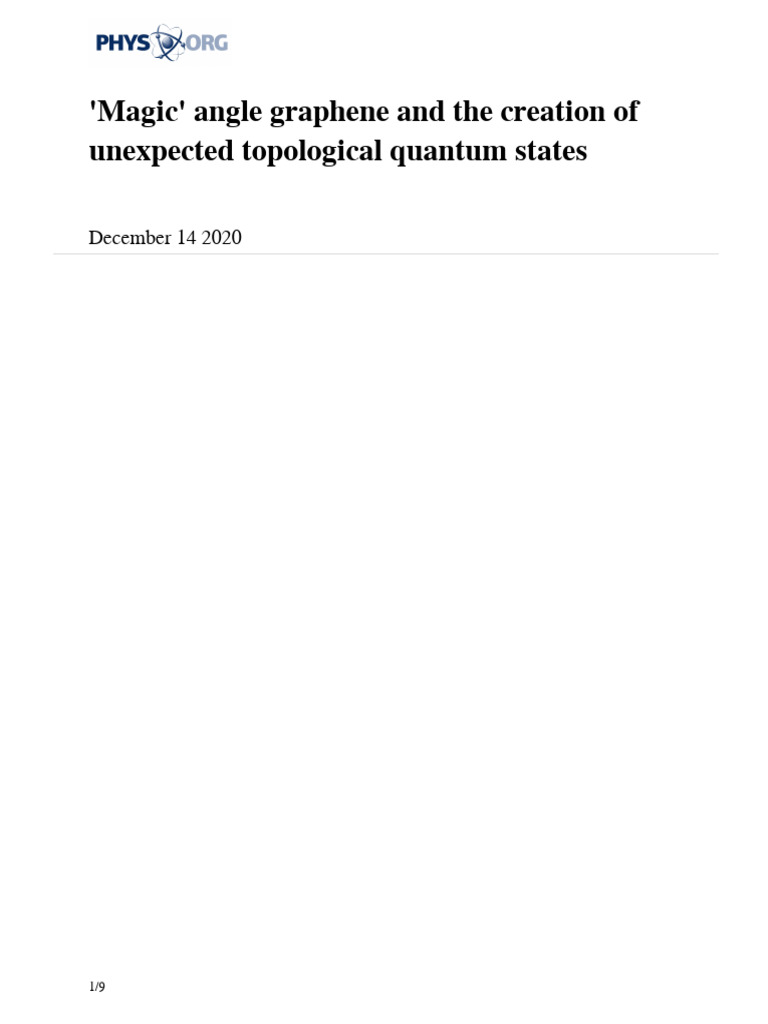Graphene, a two-dimensional allotrope of carbon, has garnered extensive attention in recent years, not only for its remarkable electrical, thermal, and mechanical properties but also for a phenomenon termed the “magic angle.” This phenomenon, characterized by a specific twist in bilayer graphene, introduces a plethora of fascinating quantum behaviors. In this discourse, we will explore the theoretical underpinnings of the magic angle in graphene, elucidate the implications of this discovery, and consider future directions for research in this captivating domain.
Understanding Graphene Structure
Graphene consists of a single layer of carbon atoms arranged in a hexagonal lattice. Its inherent properties arise from this exceptionally stable structure and the sigma and pi bond hybridization. When two layers of graphene are placed atop each other, varying their relative angles can lead to distinct electronic behaviors. The concept of the “magic angle” is seminal because it denotes a specific rotational configuration that engenders flat bands in the electronic structure of bilayer graphene. This configuration dramatically alters the material’s conductivity, enabling emergent phenomena such as superconductivity.
Defining the Magic Angle
The magic angle, denoted as approximately 1.1 degrees, emerges when two graphene layers are rotated relative to one another. Theoretical predictions indicated that at this angle, the overlapping of electronic wavefunctions results in a miniband structure. More specifically, the twist creates a condition wherein the electrons within the layers become highly correlated, leading to a flat band that fosters instability in the system. As a result, traditional electron interactions lead to unconventional responses, including superconductivity at elevated temperatures.
Theoretical Framework
The theoretical underpinnings of the magic angle can be postulated through the lens of condensed matter physics, particularly from the perspective of many-body quantum systems. The research on twisted bilayer graphene employs advanced models such as the tight-binding approach, which considers the hopping integrals between lattice sites. This model allows for the analysis of how changes in rotational angles influence the electronic band structure. At the magic angle, the effective mass of electrons approaches zero, heightening their mobility and thus facilitating the emergence of phenomena not typically seen in conventional superconductors.
Correlations and Superconductivity
The phenomenon of superconductivity in magic angle twisted bilayer graphene is particularly striking. Superconductivity arises from the pairing of electrons, or Cooper pairs, which can propagate through the lattice without resistance. The strong electron correlations at the magic angle create a scenario where phonon-mediated pairing is possible, suggesting that interactions beyond conventional pairing mechanisms may be at play. This aligns with the Bardeen-Cooper-Schrieffer (BCS) theory of superconductivity, yet the unique attributes of graphene necessitate the consideration of additional factors, such as electron-electron interactions and the role of spin and valley degrees of freedom.
Effects of Disorder and Temperature
When investigating the magic angle and its associated phenomena, the impact of disorder and temperature merits significant attention. Experimental observations reveal that while the magic angle supports superconductivity, the presence of impurities can disrupt electron correlations, thus impeding the formation of Cooper pairs. Moreover, temperature variations can finely tune the superconducting state; as temperature increases, the robustness of superconductivity alters dramatically, providing insight into the underlying mechanisms driving the phase transitions within the material.
Implications for Future Research
The discovery of the magic angle in graphene has profound implications not only for condensed matter physics but also for the nascent field of quantum computing. The high critical temperature for superconductivity in twisted bilayer graphene, along with its tunability, positions it as an attractive candidate for developing qubits based on topological states. Moreover, the interplay between electron correlations and geometrical frustration opens possibilities for exploring other exotic quantum phases, such as magnetism or fractional quantum Hall states.
Additionally, researchers are now investigating the potential of leveraging the magic angle phenomenon in heterostructures that combine different two-dimensional materials. By stacking various materials and aligning them at or near their respective magic angles, new emergent properties could be realized, expanding the scope of applications from electronic devices to novel superconductors.
Conclusion
The notion of the magic angle in graphene transcends mere theoretical curiosity; it represents a paradigm shift in our understanding of electron interactions in low-dimensional systems. By synthesizing advanced theoretical models with experimental techniques, researchers continue to unveil the complexities underlying this phenomenon. The promise of discovering new phases of matter and revolutionizing technological applications underscores the significance of ongoing investigations into twisted bilayer graphene and its extraordinary attributes. Thus, the exploration of graphene’s magic angle not only enriches fundamental physics but also paves the way for innovations in material science and quantum technology.












